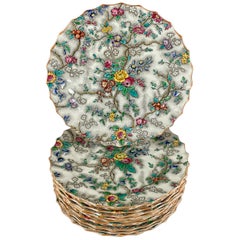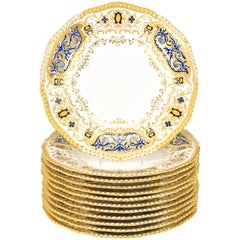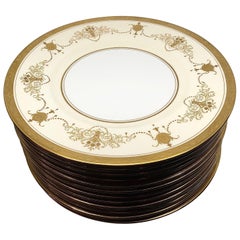Copeland Spode Patricia
Early 20th Century English Aesthetic Movement Dinner Plates
Porcelain
People Also Browsed
Vintage 1910s English Neoclassical Dinner Plates
Porcelain
Vintage 1910s Rococo Dinner Plates
Porcelain
Antique Mid-19th Century English Victorian Dinner Plates
Ironstone
Antique Mid-18th Century Italian Baroque Porcelain
Porcelain
Antique 1790s English George III Dinner Plates
Porcelain
Vintage 1970s Danish Dinner Plates
Gold, Enamel
Vintage 1930s English Art Deco Dinner Plates
Porcelain
20th Century American Art Nouveau Glass
Glass
Antique Late 19th Century French Dinner Plates
Porcelain
Early 20th Century English Belle Époque Porcelain
Porcelain
Mid-20th Century German Dinner Plates
Porcelain
Antique Early 19th Century Chinese Chinese Export Porcelain
Porcelain
Early 20th Century English Mid-Century Modern Dinner Plates
Ironstone, Paint
Vintage 1910s English Neoclassical Dinner Plates
Porcelain
Antique 1810s English Dinner Plates
Porcelain
Vintage 1920s Italian Glass
Blown Glass
Copeland Spode for sale on 1stDibs
Steeped in British history and tradition, the name Copeland Spode is renowned among porcelain collectors for its fine-quality bone china and earthenware pieces. With its roots in Spode — one of the oldest and most distinguished of the great pottery companies of Staffordshire, the time-honored home of English ceramics — Copeland Spode is known to pottery enthusiasts for some of the most timeless and recognizable patterns produced in 19th and early 20th-century porcelain manufacturing such as Wicker Lane, Chinese Rose and Tower. Collectors regard Copeland-marked pieces as Spode china.
The story of Copeland Spode china began in 1770 when English potter Josiah Spode founded a pottery and homewares company called Spode in Stoke-on-Trent, England. Within fifteen years, the manufacturer became known for its signature blue-on-white palette, and one of the company’s designers developed a specific cobalt hue for their teapots, trays, bowls and more. Spode’s founder was particularly revered for two technical achievements in the firm’s early decades. The first was to develop a standard formula for the making of bone china — a type of porcelain (made with a mixture of bone ash, minerals and clay) that is dazzlingly white and so strong it can be used to create very thin translucent plates and vessels. The other was to perfect the making of transferware.
In 1833, entrepreneurs William Taylor Copeland (the Lord Mayor of London at the time) and Thomas Garrett purchased Spode’s pottery-making company following the death of Josiah Spode III, and the name was changed to Copeland Spode. Then, in 1847, Copeland became the firm’s sole owner and the name changed again, this time to W. T. Copeland and Sons, in 1867 when Copeland retired and his four sons took over the business.
Trading as W. T. Copeland and Sons throughout the mid-to-late 19th century, the company found a formidable competitor in another well-known porcelain maker, Minton. Many of the manufacturer’s Georgian, Rococo and late-Victorian pieces such as its dinner plates, tableware, platters, bowls and baskets were commissioned by wealthy British and European clients and exported for sale throughout the British Empire and to the United States. Several of W. T. Copeland and Sons’ spectacular pieces were exhibited at the Great Exhibition of London in 1851 and the International Exhibitions of London and Paris in 1862 and 1878, respectively.
In addition to their exceptional quality and design, the company’s ceramics were particularly prized for their intricate patterns which featured a variety of colors. For instance, its popular Tower pattern was available in a pale ultramarine blue, a darker Royal Saxon blue, rose pink, brown and green.
The company continued as W. T. Copeland and Sons until 1970 when Spode again became the brand's name. Afterward, during the late 1970s, Spode, Royal Worcester and Palissy came under common ownership. In 2009, the firm was purchased by the Portmeirion Group. However, the Spode and Royal Worcester names continue to flourish as highly popular “traditional English heritage” brands within the Portmeirion company.
Find antique Copeland Spode serveware, decorative objects and more collectibles on 1stDibs.
A Close Look at aesthetic-movement Furniture
In 1880, polymath designer William Morris declared: “If you want a golden rule that will fit everybody, this is it: Have nothing in your houses that you do not know to be useful or believe to be beautiful.” His words encapsulated the Aesthetic Movement, which prized beauty above all and blurred the lines between fine art and the decorative arts, particularly through lavishly crafted furniture pieces.
The Aesthetic Movement, whose major proponents included author Oscar Wilde, flourished from the 1860s to the 1880s and was mostly popular in England and the United States. Design expositions like the 1876 Centennial International Exhibition in Philadelphia, as well as the publishing of how-to books for interior design, helped disseminate Aesthetic Movement bedroom furniture, serveware, coffee tables and other items, especially to the middle class.
The establishment of new art museums, art clubs and a rising passion for collecting at the time contributed to a growing appreciation for art. Morris’s founding of Morris & Co. in 1862 and the commercializing of this “cult of beauty” by the Liberty store in London, starting in the late 19th century, further disseminated the idea of a domestic space that was thoughtfully and floridly designed.
Leading Aesthetic Movement furniture designers included E.W. Godwin, who drew on Japanese influences and whose work reflected a wider enthusiasm for imported East Asian art. British designer Christopher Dresser created textiles, ceramics and more that were also inspired by Japanese decorative art but were representative of additional diverse design sources that ranged from Egypt to Mexico.
The Aesthetic Movement’s eclecticism resulted in dazzling interiors. Japanese fans were positioned on Renaissance-inspired cabinets with brass hardware, while mantels made of rich walnut or finely carved ebonized wood and adorned with painted Minton tiles mingled with cast-iron chairs against a backdrop of floral wallpaper. In 1881, in New York City, stenciled checkerboard motifs and painted floral murals could be found under an opalescent glass chandelier in a luxurious dressing room designed by German émigré cabinetmaker-decorator George Alfred Schastey. Amid the rise of the industrial age, the style’s promotion of art in everyday life would inform the Arts and Crafts Movement and Art Nouveau.
Find a collection of antique Aesthetic Movement seating, tables, decorative objects and other furniture and antiques on 1stDibs.
Finding the Right dinner-plates for You
Set the mood when you’re setting the table. The right antique and vintage dinner plates for the meals in your home can truly elevate the dining experience.
We haven’t had our own plate at dinner for very long. It wasn’t until the middle of the 19th century in Europe that individual dinner plates had become the norm, replacing the platters that diners had shared before them. Innovations at the dining table are believed to have been introduced by Italian noblewoman Catherine de’ Medici, who, when she married King Henry II of France in 1533, brought with her decorative table adornments for meals and fine tableware such as silver forks, replacing the fingers and knives utilized during dinner before her arrival. Italy was a bit faster on table settings, and, thanks to Catherine, tableware such as dinner plates would also replace the wooden trenchers and flat slabs of days-old bread that preceded them.
Today, while enthusiasts of mid-century modern furnishings might pine for vintage mismatched dinner plates — a mix of old and new can be refreshing — presenting ceramic vessels, glassware and decorative centerpieces that matched was once actually part of the point as setting the table became more refined during the late 19th and early 20th centuries. And as Fornasetti dinner plates and Chinese porcelain tableware have long held weight as collector’s items and status symbols, your dinner dishes haven’t ever really been merely functional. From antique metal dishes and ornamental earthenware designed by celebrated English ceramics makers Wedgwood, dinner plates are statement-making works that bring elegance and likely stir conversation at your table.
Entertaining is an art form, and the kitchen bar island and dining room table in your space are cherished gathering places where families and friends convene and grow closer over good meals. Browse an extensive collection of antique and vintage dinner plates to pair with these important events today on 1stDibs.


